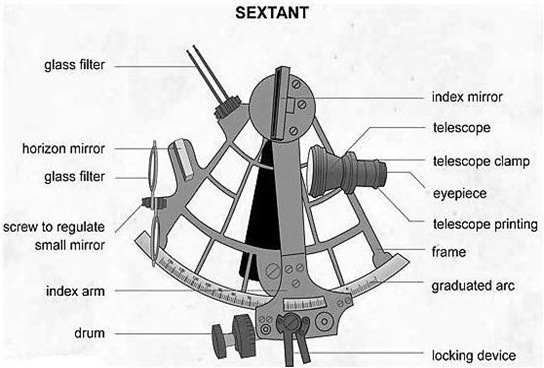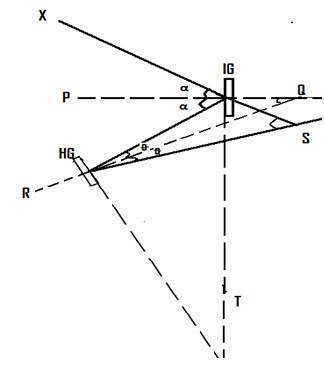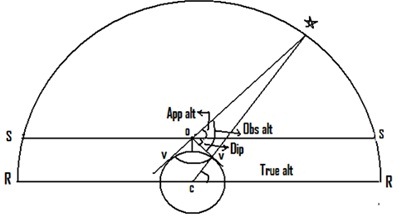Marine Sextant Explanation

Sextant is a precision instrument used for –
- Measuring altitudes of celestial bodies and horizontal angles between terrestrial objects vertical angles of terrestrial objects.
Principle of Sextant:
- When a ray of light is reflected by a plane mirror, the angle of incidence is equal to the angle of reflection, while the incident ray, reflected ray and the normal lying in the same plane.
- When a ray of light, suffers two successive reflections in the same plane, by two plane mirrors, the angle between the incident ray and the final ray is twice the angle between the mirrors.
Formulae for Sextant:-

To prove angle S = twice angle Q
a = Q + Q
Q = a – Q
Multiplying by 2, 2Q = 2 a – 2 Q ….. (i)
Again 2 a = 2 Q + S
(Ext. angle = sum of interior opposite angles)
Substituting in (i), 2Q = 2Q + S – 2Q = S
Reading of Sextant:
- When the sextant reads zero, Index mirror and horizon glasses are parallel to each other.
- When the index bar is rotated through an angle, the angle between the incident ray and the final reflected ray.
- The arc of the sextant is only 60° in extent, Micrometer is provided to measure accurate reading upto 0.1°.
Errors of Sextant:
Two types:
- Adjustable errors:
- Error of perpendicularity:- Caused when the index mirror is not perpendicular to the plane of the sextant.
- Side error:- Caused when the horizon glass is not perpendicular to the plane of the sextant.
- Index error:- When the index bar is set at zero, the plane of the index mirror and horizon glass are NOT parallel to each other.
- Error of collimation:- When the axis of the telescope is not parallel to the plane of the sextant.
- Non-Adjustable errors:
- Graduation error:- due to inaccurate graduation of the scale on the arc or of the micrometer/vernier.
- Shade error:- due to the 2 surfaces of the coloured shades not being exactly parallel to each other.
- Centering error:- pivot of the index bar not coincident with the centre of the circle of which the arc is a part.
- Optical Error:- may be caused by the prismatic errors of the mirror or aberrations in the telescope lenses.
- Back-lash:- Wear on the rack and worm, which forms the micrometer movement would cause a back-lash, leading to inconsistent errors.
- Index error, how to determine:
- During day time, clamp the index bar at zero and holding the sextant vertically, view the horizon through the telescope.
- If the true horizon and its reflection appear in the same line, Index error is not present.
- If they appear displaced vertically, turn the micrometer drum till they are in the same line.
- The micrometer reading then is the index error, which is on the arc if the micrometer reading is more than zero, off the arc if it is less than zero.
Corrections of Sextant Altitude:-

- Visible horizon: Is the small circle on the earth’s surface, bounding the observer’s field of vision at sea.
- Sensible horizon: Is a small circle on the celestial sphere, the plane of which passes through the observer’s eye, and is parallel to the observer’s rational horizon.
- Rational horizon: The observer’s rational horizon is a great circle on the celestial sphere every point on which is 90° away from his zenith.
- Observed altitude: Of a celestial body is the angle at the observer between the body and the direction to the observer’s visible or sea horizon. The observed altitude is therefore, the sextant altitude corrected
for any index error. - Dip: Is the angle at the observer between the plane of observer’s sensible horizon and the direction to his visible horizon. Dip occurs because the observer is not situated at the sea level. The value of dip increases
as the observer’s height. - Apparent altitude: Is the sextant altitude corrected for Index error and dip.


